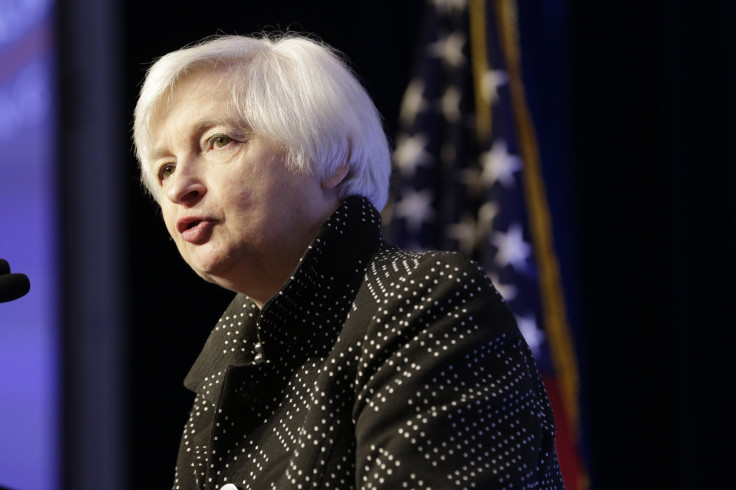Fed Chair Janet Yellen Stays Dovish Ahead Of Federal Reserve’s April Rate-Setting Meeting

UPDATE: 1:30 p.m. EDT — In a question-and-answer session after her speech at the Economic Club of New York Tuesday, U.S. Federal Reserve Chair Janet Yellen explained how she could square an upbeat message on the wider economy with a cautious approach to boosting interest rates.
While the American economy has recently “progressed in a remarkably satisfactory manner,” Yellen said, weaker global growth expectations warranted recent downwardly revised projections. “Ideally, we want to get ahead of that development,” she said.
Additionally, Yellen noted the puzzlingly slow pace of productivity growth, which has run below historical averages throughout the post-crisis recovery. That development is “a source of huge uncertainty” with respect to longer-term economic potential, she said. And the Fed chair again pointed out that fiscal policy had proven a headwind to economic growth, implying that government spending could spur greater output.
Original story:
Federal Reserve Chair Janet Yellen backed a careful approach to adjusting monetary policy Tuesday in a speech at the Economic Club of New York, saying it was “especially warranted” that the Fed “proceed cautiously in adjusting policy” in coming months.
Given the fact the Fed’s benchmark interest rate is already close to its lower bound, Yellen said it would be important not to choke off the economic recovery too soon and be forced to double down on monetary easing.
The Fed chief’s comments came as the rift between the central bank’s hawks and doves has grown more apparent, with speeches by Fed officials in recent weeks highlighting their divergent views on the resilience of the economy.
On one end, policymakers such as Federal Reserve Bank of St. Louis President James Bullard have stuck to projections made in previous months to impose multiple interest rate increases in 2016, possibly beginning when the rate-setting Federal Open Market Committee (FOMC) meets next month.
“You get another strong jobs report, it looks like labor markets are improving, you could probably make a case for moving in April,” Bullard said in an interview with Bloomberg News last week, warning that a failure to live up to previous projections could imperil the Fed’s credibility.
On the other end, an equally insistent group has argued that signs of economic weakness should preclude the Fed from putting the breaks on the economy any time soon. This group includes Lael Brainard, a Fed governor who has cautioned against lifting its benchmark interest rate absent sustained growth. “We should not take the strength in the U.S. labor market and consumption for granted,” Brainard said this month.
Recent economic data have only bolstered the cautious outlook. Consumer spending in February remained muted, with a previously reported 0.5 percent rise in January revised down to a tepid 0.1 percent. Core inflation, excluding food and energy prices, held steady at an annual 1.7 percent, below the Fed’s desired 2 percent.
The data released Monday further convinced investors that the Fed in April will keep its benchmark rate in the current range between 0.25 percent and 0.5 percent. Traders see just one rate hike in store for 2016, according to futures data compiled by CME Group. Yellen did not mention the possibility of a rate hike in April.
Fed policymakers are in the process of recalibrating in the wake of a series of market jolts in the first months of the year and continuing weakness in foreign growth and domestic output. After ditching December’s projections of raising interest rates roughly four times in 2016, the rate-setting FOMC has struggled to achieve a consistent message about future policy moves.
In her speech Tuesday, Yellen pointed to shocks in global markets, including “significant changes in oil prices, interest rates and stock values” and weaker-than-expected foreign growth. Although she said these developments had not materially affected the Fed’s baseline outlook for the U.S. economy, they still proved consequential.
In their most recent outlook in March, FOMC members eased their expectations to just two rate hikes this year, citing slowing economic growth and persistently low inflation.
“Most committee participants now expect that achieving economic outcomes similar to those anticipated in December will likely require somewhat lower interest rates,” Yellen said at the time. “I’m wary and haven’t yet concluded that we have seen any significant uptick that will be lasting.”
Yellen took a similar tack Tuesday. “The inflation outlook has also become somewhat more uncertain since the turn of the year, in part for reasons related to risks to the outlook for economic growth,” she said.
The hawks don’t want to wait. Highlighting “the first stirrings” of rising inflation in February, Fed Vice Chairman Stanley Fischer warned that the central bank’s current stance of keeping rates historically low as unemployment remains below 5 percent could “risk an undesirable rise in inflation that might require a relatively abrupt policy tightening.”
Although Yellen voiced this concern, it remains a minority view among the Fed’s rate-setting committee members, and Yellen has suggested the recent two-month uptick in core inflation could be transitory. Deutsche Bank economists echoed that message Tuesday, noting “the recent pickup in core inflation is temporary because it has not occurred alongside any noticeable increase in wage pressures.” Led by Joseph LaVorgna, the Deutsche Bank team pointed out, “At present, the economy remains weak, and there is little evidence to support higher wage growth and inflation.”
Meanwhile, Yellen stressed the Fed’s decisions are data-dependent and are subject to change with new economic data. “This forecast is not a plan set in stone that will be carried out regardless of economic developments,” she said. “Instead, monetary policy will, as always, respond to the economy’s twists and turns.”
© Copyright IBTimes 2025. All rights reserved.






















